Digital Age and Global Education PDF
Added on 2022-01-25
21 Pages6610 Words24 Views
Digital Age and Global Education
By
Abstract
The focus of all of this intense interchange was the shape and future of learning institutions. Our
charge was to accept the challenge of an Information Age and acknowledge, at the conceptual as
well as at the methodological level, the responsibilities of learning at an epistemic moment when
learning itself is the most dramatic medium of that change. This is an idealistic claim about the
primacy of learning that the single most important characteristic of the Future of classroom
learning in a Digital Age is its capacity to allow for a worldwide community and its endlessly
myriad subsets to exchange ideas, to learn from one another in a way not previously available.
We contend that the future of learning institutions demands a deep, epistemological appreciation
of the profundity of what the Internet offers humanity as a model of a learning institution.
Keywords: Internet, Digital World, Classroom, Technology
Introduction
Current Scenario of Our Education System
During the last decade, as the Internet and multimedia technology became widespread,
enthusiasm for the use of computers in schools also became more evident across the United
States. Attendance at educational technology conferences rose sharply; hundreds of businesses
started up to offer hardware, software and related services to education; and thousands of
teachers took courses to help them utilize newer technology in their classrooms. Outside the
school system enthusiasm grew as well despite the publication in newspapers and magazines of
several articles critical of the growing reliance on computers in schools (Ronald, Anderson and
Ronnkvist, 1998) Will classrooms still exist in 20 years from now? Do we have traditional
classrooms in a physical sense anymore? What is the classroom anyway?
By
Abstract
The focus of all of this intense interchange was the shape and future of learning institutions. Our
charge was to accept the challenge of an Information Age and acknowledge, at the conceptual as
well as at the methodological level, the responsibilities of learning at an epistemic moment when
learning itself is the most dramatic medium of that change. This is an idealistic claim about the
primacy of learning that the single most important characteristic of the Future of classroom
learning in a Digital Age is its capacity to allow for a worldwide community and its endlessly
myriad subsets to exchange ideas, to learn from one another in a way not previously available.
We contend that the future of learning institutions demands a deep, epistemological appreciation
of the profundity of what the Internet offers humanity as a model of a learning institution.
Keywords: Internet, Digital World, Classroom, Technology
Introduction
Current Scenario of Our Education System
During the last decade, as the Internet and multimedia technology became widespread,
enthusiasm for the use of computers in schools also became more evident across the United
States. Attendance at educational technology conferences rose sharply; hundreds of businesses
started up to offer hardware, software and related services to education; and thousands of
teachers took courses to help them utilize newer technology in their classrooms. Outside the
school system enthusiasm grew as well despite the publication in newspapers and magazines of
several articles critical of the growing reliance on computers in schools (Ronald, Anderson and
Ronnkvist, 1998) Will classrooms still exist in 20 years from now? Do we have traditional
classrooms in a physical sense anymore? What is the classroom anyway?
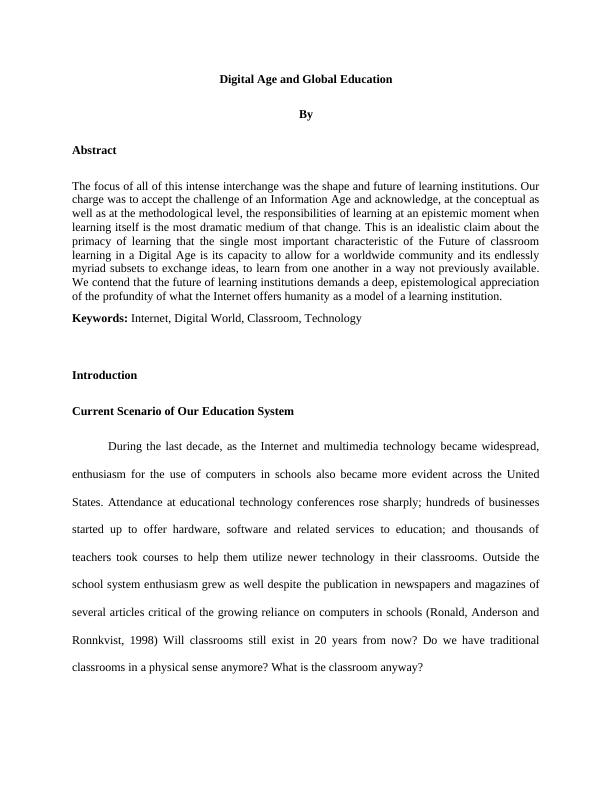
For most of me, a classroom consists of four walls, ‘closed’ doors, chairs, tables, perhaps
a blackboard, and sometimes a desk - simple but efficient pieces of furniture. A quick glance at
the history of pedagogical practices reveals that the classroom has scarcely evolved over a period
of many years. Is the traditional classroom intrinsically outdated or has it rather survived the test
of time because it is already self-reconfigurable and has been adapted in many different contexts
of use? Do we even need a classroom anymore? Do we need a teacher in the classroom? What do
we teach and what do we want pupils to learn? What kinds of knowledge and skills will be
required in the future? These are some of the questions that one should bear in mind when
thinking about the classroom of the future (Siegl, Zottmann, Kaplan and Fischer 2010).
Nowadays, it is a global trend that young brains are being attracted more towards
technological education. There is no doubt that science and technology are complementary in
nature and have to grow hand in hand. Besides, the growth of knowledge, research in
fundamental science always adds an inevitable input to the advancement of technology. Malik
and Malik (2019) find that having a home computer is associated with higher test scores in
mathematics and reading, even after controlling for family income and for cultural and social
capital. However, children from high socioeconomic status (SES) homes achieve larger
educational gains from home computers than do lower SES children. Boys' performance
advantage is larger than girls' (Attewell and Battle (1999). Quick and highly paid job
opportunities have always been an added advantage for the technology graduates. Further, they
are not encouraged to have crazy ideas. The prevalent system of teaching and evaluation
(especially in Nigeria) does not provide any opportunity for this purpose. Starting from the
primary to the higher education, the present emphasis is on maximization of the quantity of
information instead of leaving room for imagination or recreation of minds. Malik and Malik
a blackboard, and sometimes a desk - simple but efficient pieces of furniture. A quick glance at
the history of pedagogical practices reveals that the classroom has scarcely evolved over a period
of many years. Is the traditional classroom intrinsically outdated or has it rather survived the test
of time because it is already self-reconfigurable and has been adapted in many different contexts
of use? Do we even need a classroom anymore? Do we need a teacher in the classroom? What do
we teach and what do we want pupils to learn? What kinds of knowledge and skills will be
required in the future? These are some of the questions that one should bear in mind when
thinking about the classroom of the future (Siegl, Zottmann, Kaplan and Fischer 2010).
Nowadays, it is a global trend that young brains are being attracted more towards
technological education. There is no doubt that science and technology are complementary in
nature and have to grow hand in hand. Besides, the growth of knowledge, research in
fundamental science always adds an inevitable input to the advancement of technology. Malik
and Malik (2019) find that having a home computer is associated with higher test scores in
mathematics and reading, even after controlling for family income and for cultural and social
capital. However, children from high socioeconomic status (SES) homes achieve larger
educational gains from home computers than do lower SES children. Boys' performance
advantage is larger than girls' (Attewell and Battle (1999). Quick and highly paid job
opportunities have always been an added advantage for the technology graduates. Further, they
are not encouraged to have crazy ideas. The prevalent system of teaching and evaluation
(especially in Nigeria) does not provide any opportunity for this purpose. Starting from the
primary to the higher education, the present emphasis is on maximization of the quantity of
information instead of leaving room for imagination or recreation of minds. Malik and Malik
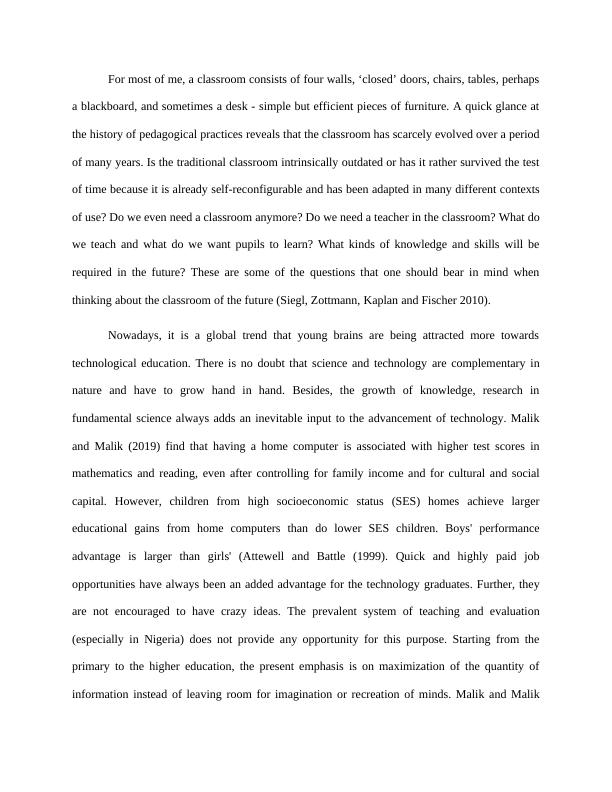
(2019) opine that one should not forget that the creative mind always has no problem in
acquiring information on its own.
New Type of Teacher and Student
Teachers taking part in remote education must fulfill various essential pre-requisites. They will
have to be fully familiar with all distance education technology. Teachers should be trained in
the use of new technologies. This training will be continuous given the constantly changing
demands of distance education and the new opportunities offered by the rapid renewal of
technologies. Their homes and workplaces should be well equipped. Quality education requires
teachers’ homes to be supplied with standard computer and communications equipment. This
equipment must be updated periodically. New digital habits must be acquired. The process of
transition from a predominantly analog classroom academic world to a digital and virtual world
is slow. Teachers should eliminate printed information wherever possible, replacing paper by
bits.
Digital Presence and Digital Futures
Digital technologies increasingly enable and encourage social networking and interactive,
collaborative engagements, including those implicating and impacting learning. And yet
traditional learning institutions, whether primary or institutions of higher learning, continue to
privilege individualized performance in assessments and reward structures. Born and matured
out of a century and a half of institutional shaping, maturing, and hardening, these assessment
and reward structures have become fixed in place. But they now serve also to weigh down and
impede new learning possibilities. Digital technologies have dramatically encouraged
acquiring information on its own.
New Type of Teacher and Student
Teachers taking part in remote education must fulfill various essential pre-requisites. They will
have to be fully familiar with all distance education technology. Teachers should be trained in
the use of new technologies. This training will be continuous given the constantly changing
demands of distance education and the new opportunities offered by the rapid renewal of
technologies. Their homes and workplaces should be well equipped. Quality education requires
teachers’ homes to be supplied with standard computer and communications equipment. This
equipment must be updated periodically. New digital habits must be acquired. The process of
transition from a predominantly analog classroom academic world to a digital and virtual world
is slow. Teachers should eliminate printed information wherever possible, replacing paper by
bits.
Digital Presence and Digital Futures
Digital technologies increasingly enable and encourage social networking and interactive,
collaborative engagements, including those implicating and impacting learning. And yet
traditional learning institutions, whether primary or institutions of higher learning, continue to
privilege individualized performance in assessments and reward structures. Born and matured
out of a century and a half of institutional shaping, maturing, and hardening, these assessment
and reward structures have become fixed in place. But they now serve also to weigh down and
impede new learning possibilities. Digital technologies have dramatically encouraged
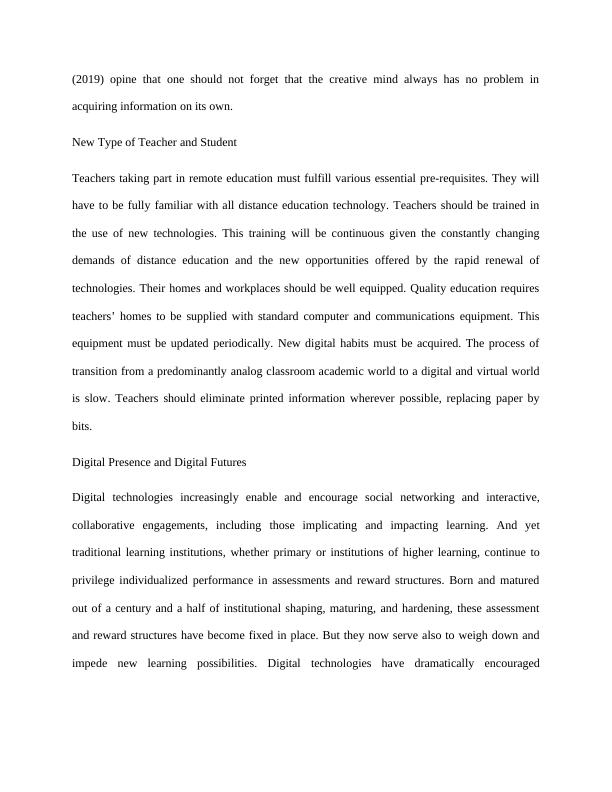
selflearning. Web interfaces have made for less hierarchical and more horizontal modes of
access.
The Web has also facilitated the proliferation of information, from the inane and banal to the
esoteric and profound, from the patently false, misleading.
New Digital Culture
In practice this road towards greater unity in human society requires a change in culture,
beginning with a profound change in daily working habits. This in turn supposes special training
which is not easy but is worth the effort as the advantages are obvious. In the first place there is a
leveling of leisure and study time. The stress of change will be reduced. Initially, hybrid
situations will exist, such as the coexistence of printed and digital texts, as when an architect
displays a design on paper that has been generated by computer, and which could be consulted
directly on the screen. With time it is possible to acquire the habit of communicating without
paper. Even fax paper turns out to be obsolete in the face of the modem/fax that enables
messages to be sent and received directly from computers. Once the network between students
and professors has been established, progress is made at a different pace.
Technology in Today’s Classrooms
Do you remember lugging your books to and from school every day? How about stuffing them
in your locker while trying to keep track of your calculator, pens, and pencils? For future
students and even some current ones, these common school quandaries may never be a problem
again. Computers and advancing technology are changing the way classrooms work and
providing students new ways to learn. The formidable expansion of the digital environment in
our planet is one of the most urgent challenges of this century. This new environment supports
access.
The Web has also facilitated the proliferation of information, from the inane and banal to the
esoteric and profound, from the patently false, misleading.
New Digital Culture
In practice this road towards greater unity in human society requires a change in culture,
beginning with a profound change in daily working habits. This in turn supposes special training
which is not easy but is worth the effort as the advantages are obvious. In the first place there is a
leveling of leisure and study time. The stress of change will be reduced. Initially, hybrid
situations will exist, such as the coexistence of printed and digital texts, as when an architect
displays a design on paper that has been generated by computer, and which could be consulted
directly on the screen. With time it is possible to acquire the habit of communicating without
paper. Even fax paper turns out to be obsolete in the face of the modem/fax that enables
messages to be sent and received directly from computers. Once the network between students
and professors has been established, progress is made at a different pace.
Technology in Today’s Classrooms
Do you remember lugging your books to and from school every day? How about stuffing them
in your locker while trying to keep track of your calculator, pens, and pencils? For future
students and even some current ones, these common school quandaries may never be a problem
again. Computers and advancing technology are changing the way classrooms work and
providing students new ways to learn. The formidable expansion of the digital environment in
our planet is one of the most urgent challenges of this century. This new environment supports
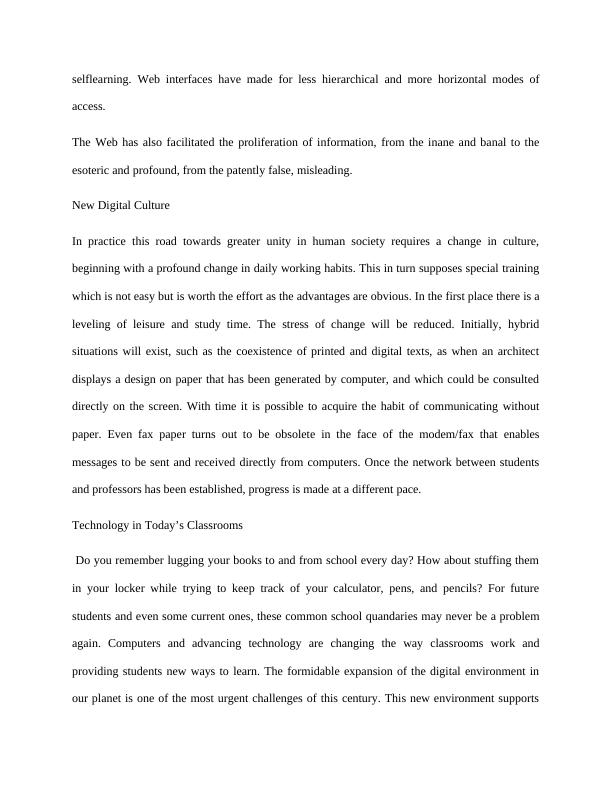
most human activities around the world today. Among the multiple social changes empowered
by the digital environment we must emphasize the transformation of the education of the new
generations, the so-called “digital natives.” The access to this digital environment is now
becoming a hope for millions of students and teachers, a way to overcome ignorance and
poverty. It is a human right, and a value in itself. At the same time the digital environment is
becoming the common ground for the mind, brain and education sciences. Malik and Malik
(2019) thinks that the future of education will depend on the increasing integration of these
sciences. And education is the hope of humanity. The teacher is facing new pedagogical
challenges in a globalized world. We should however acknowledge the fact that while we have
significant information about the learning brain we lack a similar knowledge of the teaching
brain. Our expectation is to bridge this neuro-cognitive gap in the next years (Battro 1997).
Today, the blackboard has become a whiteboard; chalk has become a magic marker; the slates
that students used have been replaced by notebooks; and classes have sometimes gotten smaller.
Little else has changed. True, some schools are providing their students with laptops, and
teachers are increasingly using technology and encouraging collaboration. But the methods are
essentially the same—with the teacher dictating learning (Wadhwa, 2015).
Technologies that has Changed the Digital Classroom
In the past, the suggestion of getting a college degree without ever cracking a book meant
paying a degree mill. It meant the degree was in name only, reflecting neither learning nor effort.
Then distance learning meant correspondence courses, perhaps combined with some coordinated
telecasts. Technology has already changed all that, and the future will change it even further and
they are:
by the digital environment we must emphasize the transformation of the education of the new
generations, the so-called “digital natives.” The access to this digital environment is now
becoming a hope for millions of students and teachers, a way to overcome ignorance and
poverty. It is a human right, and a value in itself. At the same time the digital environment is
becoming the common ground for the mind, brain and education sciences. Malik and Malik
(2019) thinks that the future of education will depend on the increasing integration of these
sciences. And education is the hope of humanity. The teacher is facing new pedagogical
challenges in a globalized world. We should however acknowledge the fact that while we have
significant information about the learning brain we lack a similar knowledge of the teaching
brain. Our expectation is to bridge this neuro-cognitive gap in the next years (Battro 1997).
Today, the blackboard has become a whiteboard; chalk has become a magic marker; the slates
that students used have been replaced by notebooks; and classes have sometimes gotten smaller.
Little else has changed. True, some schools are providing their students with laptops, and
teachers are increasingly using technology and encouraging collaboration. But the methods are
essentially the same—with the teacher dictating learning (Wadhwa, 2015).
Technologies that has Changed the Digital Classroom
In the past, the suggestion of getting a college degree without ever cracking a book meant
paying a degree mill. It meant the degree was in name only, reflecting neither learning nor effort.
Then distance learning meant correspondence courses, perhaps combined with some coordinated
telecasts. Technology has already changed all that, and the future will change it even further and
they are:
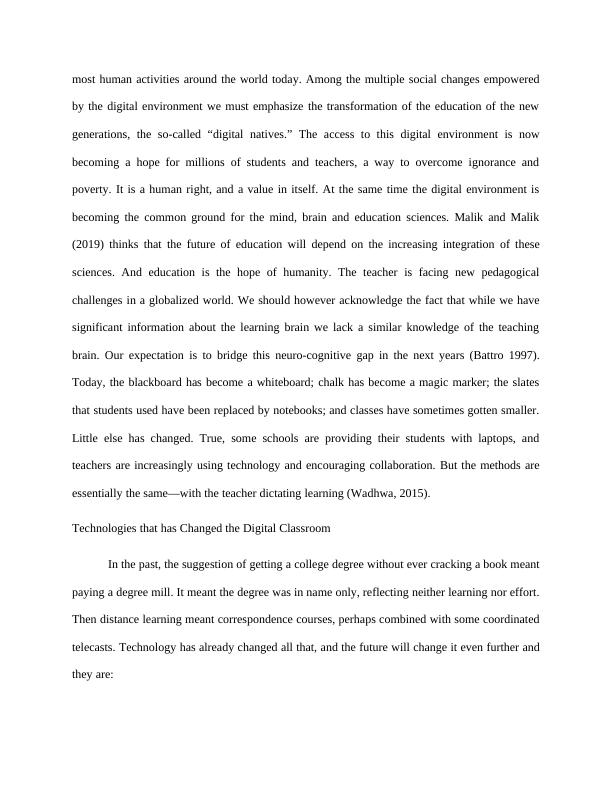
1. eTexts - Now, online college students can obtain legitimate college degrees without cracking a
book– but that doesn’t mean they don’t have to read. Even with hard copy texts available, most
students download their textbooks in password protected Portable Document Format (PDF). Not
only is this a “green” alternative, but you avoid the weight of having to carry around textbooks.
Students can copy the PDF to mobile devices, and carry all of their texts on one iPad or Galaxy
Tab. They choose to print whole books, only parts, or just use the digital document. A drawback
to depending on protected PDFs is that they only open with active internet connections — but
once opened students can use them until closed.
2. Virtual Libraries Most online school programs — even those which still use correspondence
course designs have robust virtual libraries – something that never existed 15 years ago. Many
colleges and universities contract with EBSCO Publishing to maximize available peer reviewed
journals. Even traditional students use in college libraries. Distance learners access the same
journals as campus students — from anywhere in the world. Students quickly build up their own
virtual libraries of thousands of journal articles, just as mobile as any e-text. Renaming these
files as closely as possible to the required bibliographic format, and cataloguing them, keeps
them organized, accessible, and easy to cite in papers.
3. Online School Portals - Until now resources for modern distance learning seem only different
in form from correspondence courses. That changes with portals. These virtual campuses come
complete with individual rooms for each class. They are so significant an innovation that they
could change the future of on campus studies. Anticipating how ubiquitous technology should
become, some schools already require even on-campus students to take at least one class online.
This innovation means students need not all be present at once. More, many schools are now
book– but that doesn’t mean they don’t have to read. Even with hard copy texts available, most
students download their textbooks in password protected Portable Document Format (PDF). Not
only is this a “green” alternative, but you avoid the weight of having to carry around textbooks.
Students can copy the PDF to mobile devices, and carry all of their texts on one iPad or Galaxy
Tab. They choose to print whole books, only parts, or just use the digital document. A drawback
to depending on protected PDFs is that they only open with active internet connections — but
once opened students can use them until closed.
2. Virtual Libraries Most online school programs — even those which still use correspondence
course designs have robust virtual libraries – something that never existed 15 years ago. Many
colleges and universities contract with EBSCO Publishing to maximize available peer reviewed
journals. Even traditional students use in college libraries. Distance learners access the same
journals as campus students — from anywhere in the world. Students quickly build up their own
virtual libraries of thousands of journal articles, just as mobile as any e-text. Renaming these
files as closely as possible to the required bibliographic format, and cataloguing them, keeps
them organized, accessible, and easy to cite in papers.
3. Online School Portals - Until now resources for modern distance learning seem only different
in form from correspondence courses. That changes with portals. These virtual campuses come
complete with individual rooms for each class. They are so significant an innovation that they
could change the future of on campus studies. Anticipating how ubiquitous technology should
become, some schools already require even on-campus students to take at least one class online.
This innovation means students need not all be present at once. More, many schools are now
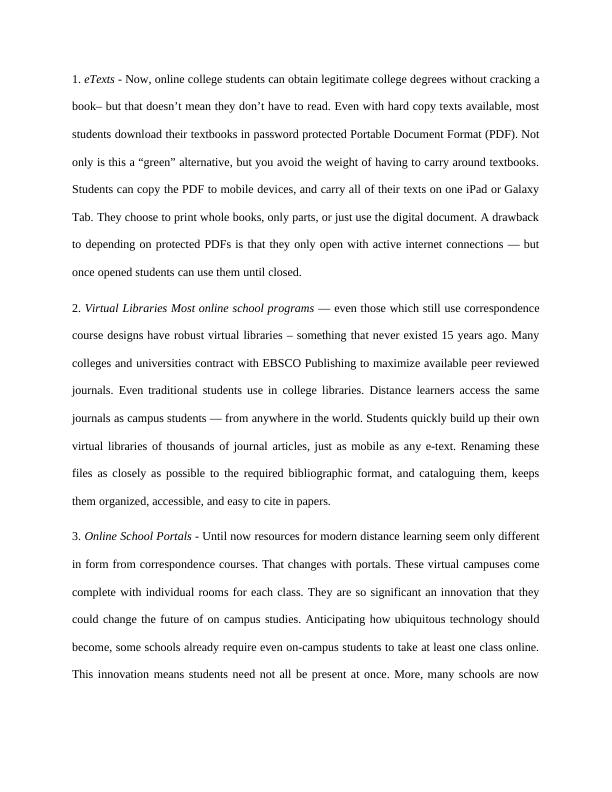
End of preview
Want to access all the pages? Upload your documents or become a member.
Related Documents
Media Arts in Child's Educationlg...
|4
|612
|222
Science Education in the Primary Yearslg...
|11
|3088
|36
Digital Learning Assignment 2022lg...
|8
|2083
|23
EMV501 - The Advent of Science and Advanced Technology - Education Systemlg...
|6
|1551
|421
1. Name:. Instructor:. Course:. Date:. The addition oflg...
|4
|442
|51
The Increase in use of Technology Within Schools and Educational Settingslg...
|10
|3184
|21
